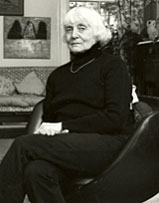Non Fiction
The Erotic World of Faery (1972)
 In her first full-length non-fiction work, Maureen Duffy examines the erotic meanings, hidden or obvious, behind the fantastic element in English literature. Those who have read her fiction will realise that she has long been interested in questions of myths. Now from the Dark Ages and the decline of the pagan gods and the fertility cults to the science fiction of the present day she traces themes, symbolisms, shifting nuances, double meanings whether conscious or unconscious, and a whole underworld of myth. She examines the clash between the world of St Augustine and the pagan world of the satyr; she looks at the coming of the fairies into the Christian twilight, and the concept of the elfin and the Arthurian knight; and gives us a glimpse of the rich background of folk legend.
In her first full-length non-fiction work, Maureen Duffy examines the erotic meanings, hidden or obvious, behind the fantastic element in English literature. Those who have read her fiction will realise that she has long been interested in questions of myths. Now from the Dark Ages and the decline of the pagan gods and the fertility cults to the science fiction of the present day she traces themes, symbolisms, shifting nuances, double meanings whether conscious or unconscious, and a whole underworld of myth. She examines the clash between the world of St Augustine and the pagan world of the satyr; she looks at the coming of the fairies into the Christian twilight, and the concept of the elfin and the Arthurian knight; and gives us a glimpse of the rich background of folk legend.
With the Renaissance is revealed a transmutation of the whole atmosphere of faery, and Miss Duffy looks closely at what Spenser meant in the Faerie Queene and what Shakespeare meant in A Midsummer Night’s Dream and later, differently, in The Tempest. Milton’s supernatural is different again; and the satires of Pope and Swift mark another mutation. Gothic novels and fairy tales, Romantics and Pre-Raphaelites, ’decadents’, exponents of whimsy, teachers and tellers of children’s stories, all have their own expression of the fantastic, each with its underlying significance.
Not least in importance is the whole idea of the ‘other’ in modern fiction. The illustrators of the faery world also receive some penetrating looks: Fuseli, Doyle, Beardsley, all make their contribution.
The Passionate Shepherdess: Aphra Behn, 1640-89 (1977)
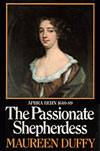 The barest facts of the life of Aphra Behn are astonishing in themselves. Born in 1640 of comparatively obscure parentage in Kent, she had, by her mid-twenties, travelled to South America, returned to England, been married and widowed. She was sent by Charles II as a spy to Antwerp and became involved in the complex politics of the Anglo-Dutch War; then, on her return, she was imprisoned for debt. Once out of prison, she was faced with the problem of survival, and the options open to d dowerless but beautiful woman in the 17th century were few. She could marry, she could be kept or she could try to keep herself. Incredibly, it must have seemed to many people, she chose the last and became one of the most successful dramatists of the Restoration theatre, author of one of the most popular and influential novels of the period, Oroonoko, and a poet of such reputation that men at the time were moved to consider seriously the possibility of a ‘female laureate’.
The barest facts of the life of Aphra Behn are astonishing in themselves. Born in 1640 of comparatively obscure parentage in Kent, she had, by her mid-twenties, travelled to South America, returned to England, been married and widowed. She was sent by Charles II as a spy to Antwerp and became involved in the complex politics of the Anglo-Dutch War; then, on her return, she was imprisoned for debt. Once out of prison, she was faced with the problem of survival, and the options open to d dowerless but beautiful woman in the 17th century were few. She could marry, she could be kept or she could try to keep herself. Incredibly, it must have seemed to many people, she chose the last and became one of the most successful dramatists of the Restoration theatre, author of one of the most popular and influential novels of the period, Oroonoko, and a poet of such reputation that men at the time were moved to consider seriously the possibility of a ‘female laureate’.
Men And Beasts: Animal Rights Handbook (1984)
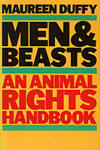 Why should millions of animals be killed for food, often cruelly? Why should animals be tormented in the so-called interests of scientific research? Why should agribusiness keep birds and mammals in what amounts to prison cells? Why should religious beliefs be allowed to justify cruel methods of slaughter? Why should thousands of household pets be abused, abandoned or killed every year?
Why should millions of animals be killed for food, often cruelly? Why should animals be tormented in the so-called interests of scientific research? Why should agribusiness keep birds and mammals in what amounts to prison cells? Why should religious beliefs be allowed to justify cruel methods of slaughter? Why should thousands of household pets be abused, abandoned or killed every year?
Maureen Duffy’s Men and Beasts is a clear statement of the case for a more enlightened attitude towards animals, based on equality and respect for their rights. It is also an action handbook, with useful advice on ow to make political pressure effective, whether by writing to the press, organising demonstrations or fund-raising.
Inherit the Earth (1980)
 ‘The Jarvisses came first, though I can’t say exactly where from. They weren’t there in the 14th century of plague and revolution.’ It was at Thaxted in Essex that the Jarvisses established themselves, and it is they who form the centre of the maze of relations and inter-marriages which gradually grew over the succeeding centuries. These people were not rich or important, though their fortunes occasionally rose only to sink back, they make their appearances, marry, have children, die. Events of national importance — the progress of Elizabeth I, the Civil War, the threat of Napoleon, the Industrial Age — touch them, but only rarely alter the tenor of their lives. There are a few scandals, a strand of non-conformism, a political radicalism, one cousin even enlisted, to fight at such strange sounding battles as Buenos Aires and Salamanca, light years away from the small Essex towns and hamlets. The Jarvisses are Everyman, a microcosm of life through the ages.
‘The Jarvisses came first, though I can’t say exactly where from. They weren’t there in the 14th century of plague and revolution.’ It was at Thaxted in Essex that the Jarvisses established themselves, and it is they who form the centre of the maze of relations and inter-marriages which gradually grew over the succeeding centuries. These people were not rich or important, though their fortunes occasionally rose only to sink back, they make their appearances, marry, have children, die. Events of national importance — the progress of Elizabeth I, the Civil War, the threat of Napoleon, the Industrial Age — touch them, but only rarely alter the tenor of their lives. There are a few scandals, a strand of non-conformism, a political radicalism, one cousin even enlisted, to fight at such strange sounding battles as Buenos Aires and Salamanca, light years away from the small Essex towns and hamlets. The Jarvisses are Everyman, a microcosm of life through the ages.
A Thousand Capricious Chances: History of the Methuen List, 1889-1989 (1989)
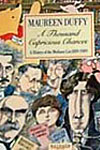 Algernon Methuen Stedman, founder in June 1889 of the Methuen list, was a schoolmaster and an author of educational textbooks. The first book he published, however, was a novel by Edna Lyall, a campaigner for women’s emancipation and other progressive causes — and Methuen’s early success was largely founded on novel publishing. The rapidly growing list was soon to embrace the work of prestigious novelists such as Henry James and Joseph Conrad, as well as the hugely popular Marie Corelli and Arnold Bennett; poets such as Rudyard Kipling; playwrights such as Oscar Wilde and Henrik Ibsen; and children’s authors such as Kenneth Graham. It was, in short, a wide-ranging literary and general list, combined with a developing children’s and educational list, and has continued as such with varying degrees of emphasis up to the present.
Algernon Methuen Stedman, founder in June 1889 of the Methuen list, was a schoolmaster and an author of educational textbooks. The first book he published, however, was a novel by Edna Lyall, a campaigner for women’s emancipation and other progressive causes — and Methuen’s early success was largely founded on novel publishing. The rapidly growing list was soon to embrace the work of prestigious novelists such as Henry James and Joseph Conrad, as well as the hugely popular Marie Corelli and Arnold Bennett; poets such as Rudyard Kipling; playwrights such as Oscar Wilde and Henrik Ibsen; and children’s authors such as Kenneth Graham. It was, in short, a wide-ranging literary and general list, combined with a developing children’s and educational list, and has continued as such with varying degrees of emphasis up to the present.
Maureen Duffy’s history focuses not only on some of the outstanding writers published by Methuen, but also on the popular writers of their day in various genres who also made up the list. The Methuen list has included Einstein, Isherwood, Brecht and Monty Python, and has introduced its readers to such diverse characters as Tarzan, Winnie the Pooh and Tintin.
A Thousand Capricious Chances is also a celebration of Methuen’s publishing over the past hundred years, highlighting both some triumphs such as the courageous reissuing of Wilde’s work after his death) and some notorious disasters (such as the banning and burning of Lawrence’s The Rainbow). By surveying the century’s varied output of one company, and the circumstances in which its books have been written and published, Maureen Duffy has compiled a remarkable cultural history of the profession of letters, and of public taste.
Henry Purcell, (1659-95) (1994)
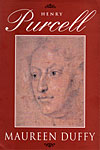 Henry Purcell set to music an entire age. Endlessly resourceful and dazzlingly innovatory Purcell’s music instantly evokes the energy and confidence of Restoration England. The age of Pepys and Dryden — of elegance, wit and boundless creativity — gave birth to an audacious new theatre and, in Purcell’s operas, to a new musical form.
Henry Purcell set to music an entire age. Endlessly resourceful and dazzlingly innovatory Purcell’s music instantly evokes the energy and confidence of Restoration England. The age of Pepys and Dryden — of elegance, wit and boundless creativity — gave birth to an audacious new theatre and, in Purcell’s operas, to a new musical form.
A working musician, Purcell was organist and harpsichordist as well as composer; tuner and repairer as well as performer. He also wrote music for every conceivable occasion: for the Church and for the theatre, for the chamber and for the great occasions of State. Purcell moved easily through the echelons of London society: from the quiet of the chapel royal to the raucous taverns. King and courtiers, actresses and innkeepers, tradesmen and artist... Purcell knew all the characters that comprised the constant flux of London life.
England: The Making of the Myth from Stonehenge to Albert (2001)
 A narrative story of the making of the myth of the English. In this study, acclaimed author Maureen Duffy surveys 3000 years of English and British history, illuminating the myths that have come to be such an important part of our national identity. "England: The Making of the Myth from Stonehenge to Albert Square" aims to change your view of England's past - and England's future.
A narrative story of the making of the myth of the English. In this study, acclaimed author Maureen Duffy surveys 3000 years of English and British history, illuminating the myths that have come to be such an important part of our national identity. "England: The Making of the Myth from Stonehenge to Albert Square" aims to change your view of England's past - and England's future.
Jump to top
